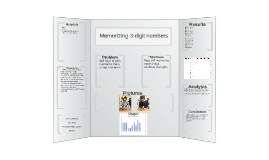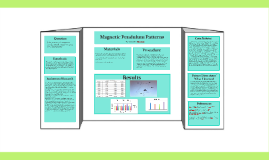Science Fair Board Samantha
Transcript: Magnetic Pendulum Patterns "Chaotic Pendulum." Chaotic Pendulum. Web. 14 Mar. 2014. <http://www.maths.uq.edu.au/~infinity/Infinity9/pendulum.html>. "How It Works." How It Works. Web. 14 Mar. 2014. <http://www.calacademy.org/products/pendulum/page8.htm>. "Magnetic Field Basics." Physics4Kids.com: Electricity & Magnetism: Magnetic Fields. Web. 12 Mar. 2014. <http://www.physics4kids.com/files/elec_magneticfield.html>. "University of Birmingham." Chaotic Motion. Web. 12 Mar. 2014. <http://www.birmingham.ac.uk/schools/chemical- engineering/weblab/Introduction-to-Chaos/Chaotic-Motion/index.aspx>. Conclusions Procedure If the pattern of the magnets is changed, will the time of the of the bob's swing change? If the pattern of the magnets is changed, than the time of the bob's swing will change because the magnetic field would have been changed, and the magnetic bob would have been pulled to a different field. Hypothesis First, put the magnets in a triangle pattern. Push the magnetic bob and time it’s swing. After timing the pendulum’s swing 10 times, change the pattern. For, example, you could put the magnets in a line or maybe a circle instead. Do this ten times, recording the time of the bob’s swing. Make sure to watch the pendulum carefully to avoid making a mistake or missing a stopping point. Maybe try a few other patterns for better results. One pattern that I tried was a stacked pattern where the magnets were stacked on top of each other. Materials Question By: Samantha Blackman Results Background Research My hypothesis was correct, and when the magnet’s pattern is changed, the time of the swing will change, too. The difference between the slowest and fastest times averages was 9.5803 seconds, and were not very far from each other. The pendulum’s pattern was very different between stacked and scattered. The stacked kept the bob in one spot, but the scattered moved the bob around more, and further distances. In conclusion, the experiment went well and the results helped to explain what happened to the bob’s pattern, and went well with the background information. Some problems that might have been run into could be the bob getting stuck to the pendulum, which would happen when swinging the bob. The timing may have been off, because when the pendulum slowed down, the timer may have stopped to early or to late, resulting in outliers in the information. Some errors could be the pattern of the magnets from day to day. The pattern would be one way one day, then the next it would be re created, but different, so it might effect the pendulum time. All together, most problems were fixed, like how the magnets would stick together at random times, and the experiment went smoothly. The results helped with the conclusions and other information by adding facts to back up the research and hypothesis. One example is the time of the swing change and average times, like in the first paragraph. The times of the swing’s average helped to show that the slowest and fastest times were not so far apart from each other. To take this a step further, you could experiment with new types of magnets. Stronger magnets may create a new outcome, such as less predictable patterns. Another way you could look into this further would be testing new types of string to see how flexible it may be. Stiffer string may make the bob move in more jolting movement instead of smooth swings. The results can help to take this a step further by comparing your times to the old average. Overall, the results will really help further research and proving a point to information, such as this experiment. In this experiment, the magnets will be put into a different pattern instead of the usual triangle pattern. You will need: • A magnetic pendulum (found on http://howtosmile.org/record/2814) • 4-6 magnets (any kind will work) A magnet is an object that gives off a magnetic field. A magnet works with the poles attracting and rejecting each other’s forces. There are negative and positive charges. The negative charges attract positive charges and the other way around. A pendulum moves using gravity and movements of the earth. The earth’s movement tilts the pendulum’s bob and makes it move one way, then the gravity pulls the bob back down, and back, and down again. The inertia of a pendulum makes it swing out, and then gravity pulls it down. Inertia is the bob’s resistance to a change in motion. Chaotic motion is the movement of random angles and other unpredicted movements. Even though the movements may seem random, the motion has a hard to follow pattern. An example would be a magnetic pendulum, which has a pattern, but the pattern is hard to pick up on. The magnetic pendulum is moved by chaotic motion, which is caused by the magnets attracting and rejecting each other’s forces. Chaotic motion makes the pendulum move randomly in different fashions. When working on this project, you really need to pay attention to due dates and what is due. Make sure to get things

















